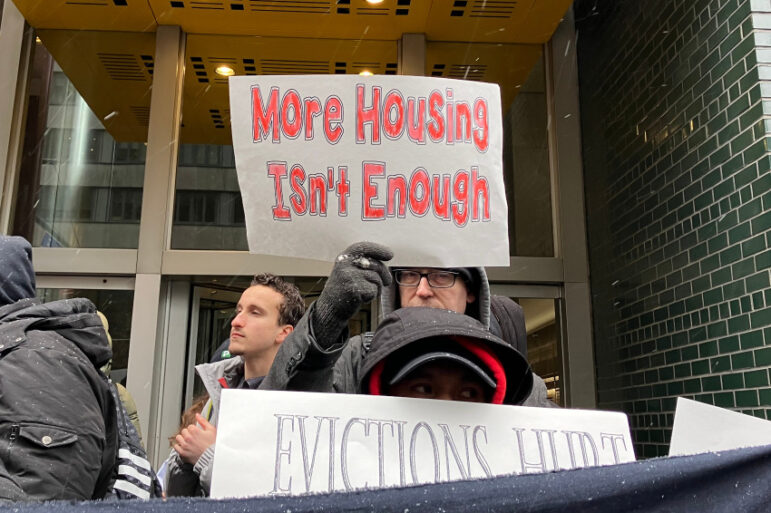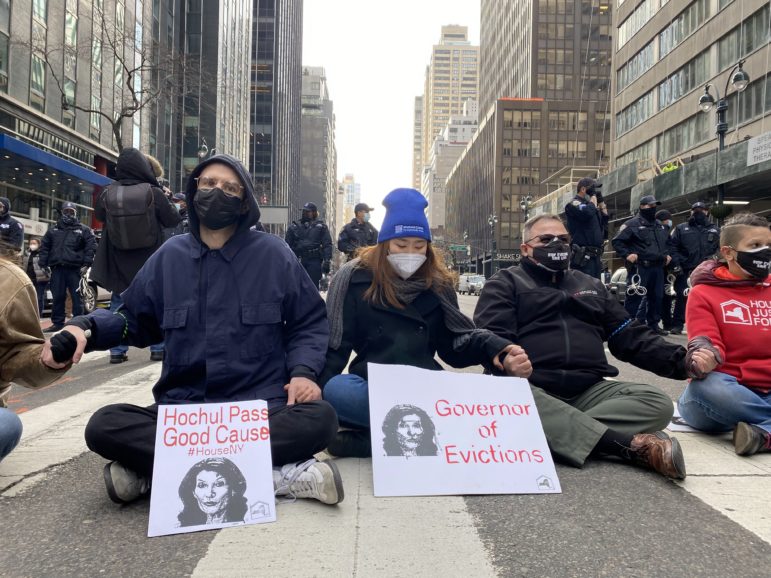The Senate and Assembly on Tuesday released their annual budget resolutions, responding to Gov. Kathy Hochul’s $227 billion spending proposal unveiled last month. They rejected the bulk of Hochul’s strategy to increase housing production statewide, while entertaining eviction protections the governor has ducked.

Emma Whitford
Tenant advocates at a rally outside Gov. Hochul’s office Tuesday.New Yorkers will have to wait a few more weeks to find out which housing policies make it into the state budget, and which get cast aside. But Albany lawmakers have now offered the first real glimpse at their priorities, which diverge sharply from the governor’s.
The Senate and Assembly on Tuesday released their annual budget resolutions, responding to the proposals Gov. Kathy Hochul laid out in her $227 billion executive budget last month. They rejected the bulk of Hochul’s strategy to increase housing production statewide, while entertaining eviction protections the governor has ducked.
Next comes intensive negotiations ahead of the April 1 budget deadline. “We have an enormous amount of work to do over the next couple weeks,” said Michael McKee, treasurer of the Tenants Political Action Committee.
Here, City Limits breaks down where the Senate and Assembly stand in a year when New York’s lack of affordable rental housing is top of mind.
Housing boost, but how?
Central to Hochul’s budget is a plan aimed at creating 800,000 new housing units over the next decade. It sets production requirements across the state, with a path for developers to override local zoning if cities and towns fail to make room for more homes. Her Housing Compact also calls for more density around train stations.
The proposal has rankled some lawmakers—both Republican and Democrat. Eastern Queens Senator Toby Ann Stavisky told City Limits that increasing density “to me makes no sense” when existing abandoned buildings might be well-suited for housing, and that people buy homes with certain expectations of enjoyment.
But Hochul’s supporters say it’s a matter of equity, saying a history of exclusionary zoning rules has fueled segregation and excluded lower income residents from certain communities.
While the Senate and Assembly did not oppose Hochul’s targets—3 percent growth every three years downstate and 1 percent upstate—they proposed a carrot rather than a stick: $500 million in incentives for towns and cities to meet the new benchmarks without, as the Senate put it, “mandatory requirements and overrides of local zoning.”
New York cannot ignore “the critical role of community input in meeting development needs,” the Senate stated.
Manhattan Assemblymember Harvey Epstein described a mix of support and opposition for Hochul’s housing plan from colleagues across the state. “I think the conflict was over telling a municipality how they should act,” he said Tuesday. “Not the targets, but what the penalties are related to not meeting those targets.”
The legislature also excluded Hochul’s transit-oriented upzoning plan, as well as a proposal favored by Mayor Eric Adams that would remove a floor-area-ratio cap to allow for taller residential buildings in New York City. Another Adams’ priority, a tax incentive to convert offices to apartments, was excluded by the Assembly and modified by the Senate.*
Andrew Fine, policy director for the pro-housing group Open New York, condemned the resolutions Tuesday, calling them “extremely weak” and the product of misinformation about the Housing Compact.
“At our meetings in Albany there’s the impression that this proposal takes away all zoning rights, or every town will have to build massive apartment buildings,” Fine said. Instead, he continued, local governments would be able to “choose how to grow,” and would only face an override if they declined to take any action to loosen zoning.
“I wanted to see deeper affordability, not local control,” said Cea Weaver, campaign coordinator with the statewide tenant coalition Housing Justice for All.
But the response from tenant advocates was not monolithic. Esteban Girón, a member of the Crown Heights Tenant Union, said he had been wary of communities losing leverage with developers that might secure lower rents in new projects, particularly in neighborhoods like his where gentrification has priced out many longtime tenants.
“We’re people who are not trying to get displaced,” he said.
Good cause rising?
First introduced in 2019, good cause eviction legislation would prevent landlords from evicting tenants without establishing good cause, such as failure to pay rent or nuisance behavior. It would also allow tenants to challenge rent increases above a certain level – either 3 percent in a year, or 1.5 times the change in the consumer price index.
“It has to happen this year. Good cause must pass,” said Dorca Reynoso, an Inwood tenant and member of the Metropolitan Council on Housing, at a rally outside of Hochul’s Manhattan office on Tuesday. Reynoso saw her rent increase 100 percent in 2014, she told City Limits, from $625 to $1,250. “You don’t have savings,” she said. “You live in a paycheck-to-paycheck mode.”
The Senate stated Tuesday that it “supports advancing tenant protections that align with the core principles of Good Cause Eviction.” Hochul, by contrast, has declined to back the concept.

David Brand
Housing activists rallied for state lawmakers to pass “good cause” eviction legislation in January 2022.“We’re definitely closer than we’ve ever been so I’m very happy about that,” Brooklyn Senator Jabari Brisport told City Limits Tuesday. “I’ve been fighting for this before I even got elected.”
Yet the Assembly did not include the words “good cause” in its resolution. Instead, the body stated that it “will continue to explore pathways to protect tenants from arbitrary and capricious rent increases and unreasonable evictions of paying tenants.”
Real estate industry groups see good cause protections as an encroachment on property rights, and argue that limits on rents could make property repairs untenable. Moving forward with the proposal this year could “lock the rental market in stasis,” warned Jay Martin, CEO of the New York City trade association CHIP.
But tenants felt emboldened Tuesday, gearing up for the negotiations to come. “I think that it shows an incredible amount of power that’s been built over recent years for this bill. The wealthiest lobby in the state hates it, and we got it mentioned by name,” said Genevieve Rand, statewide housing organizer with Citizen Action New York.
Certain good cause principles should not be up for negotiation, said Weaver of Housing Justice for All. For example, allowing localities to opt-in would be “a total no-go for us.”
What else is in the mix?
For the second year in a row, the Senate and Assembly both proposed $250 million to establish the Housing Access Voucher Program, a rental subsidy modeled after the federal Section 8 program. The proposal fizzled during budget negotiations last year, but is a rare policy backed by tenant and landlord groups alike.
The vouchers would be open to anyone who meets the eligibility requirements, regardless of immigration status, which supporters say would help asylum seekers—thousands of whom have entered the city’s homeless shelter system in recent months—secure permanent housing.
Both resolutions also call for $40 million to fund the state-run Homeowner Protection Program, or HOPP, a network of legal service providers and counselors aimed at preventing foreclosures.
HOPP members had criticized the governor for leaving the program out of her budget proposal this year. “We’re extremely gratified,” said Jacob Inwald, director of foreclosure prevention at Legal Services NYC, on Tuesday. Now comes the negotiations, he added: “The process doesn’t end until it ends.”
The Senate and Assembly also proposed about $385 million for emergency rent relief, which could potentially assist thousands of residents of public housing who have yet to see their pandemic-era applications processed.
Though neither body endorsed the Tenant Opportunity to Purchase Act, a bill intended to help tenants purchase their buildings when they go up for sale, the Assembly proposal includes funding to support housing ownership by tenant associations—a “pretty big deal,” according to Girón of the Crown Heights Tenant Union.
Excluded from both resolutions is a pathway to legalize basement and cellar apartments in New York City—a move advocates say would protect existing tenants from city vacate orders, as well as increase the city’s housing stock.
Sadia Rahman, deputy director of Chhaya CDC, accused lawmakers Tuesday of being apathetic toward “families dying in the next superstorm,” after several New Yorkers drowned in basement and cellar apartments during Hurricane Ida in 2021.
Assemblymember Epstein, who supports the legislation, told City Limits Tuesday that he hopes to get basements and cellars back into the final version of the budget, and sees “a real lane here to get it done.”

Adi Talwar
Homes along Ridgewood Avenue and Cleveland Street in Brooklyn. The city launched a basement/cellar conversion pilot program in the area in 2019.
Tax break broken?
Also missing from both budget resolutions is a replacement to an expired multi-decade tax break for housing developers in New York City, known as 421-a. The governor’s office has predicted baseline housing growth of 407,000 units in the next decade, baking in the assumption that 421-a is replaced with another comparable tax incentive.
Unveiling her housing plan in February, Hochul called a new tax incentive a “critical piece of the puzzle.” She also proposed extending the deadline for developers to complete certain projects under the expired program – a priority for the Real Estate Board of New York that the Senate and Assembly both rejected Tuesday.
Hochul’s proposals would “actually directly spur meaningful rental housing production,” Real Estate Board of New York President James Whelan said in a statement, urging the legislature to “get real about building rental housing.”
The governor also sought a 421-a replacement in 2022, but it sputtered when tenant-aligned lawmakers rejected her proposed affordability requirements.
“Last year there was a big fight against it and this year it was basically dead on arrival,” Senator Brisport said Tuesday. “We didn’t even have to fight against it – it just wasn’t really a strong consideration.”
*Correction: An earlier version of this story misstated the Senate’s proposal for converting commercial properties to apartments.








